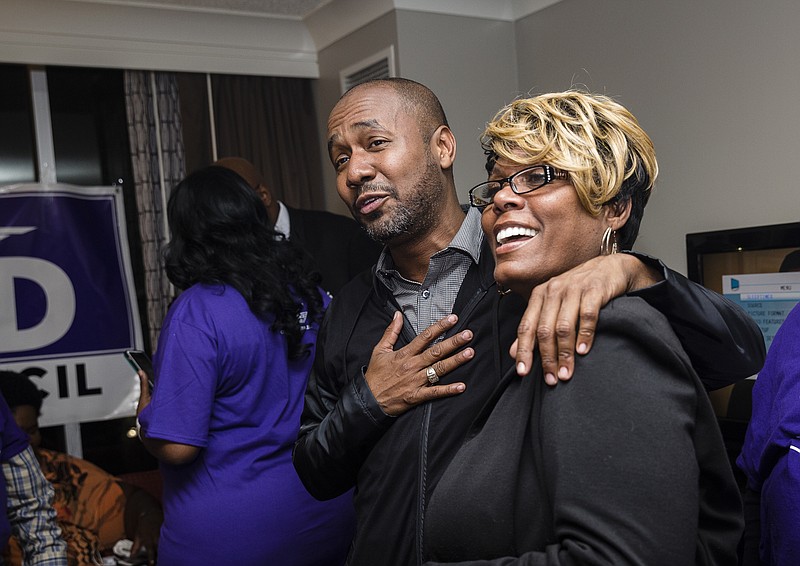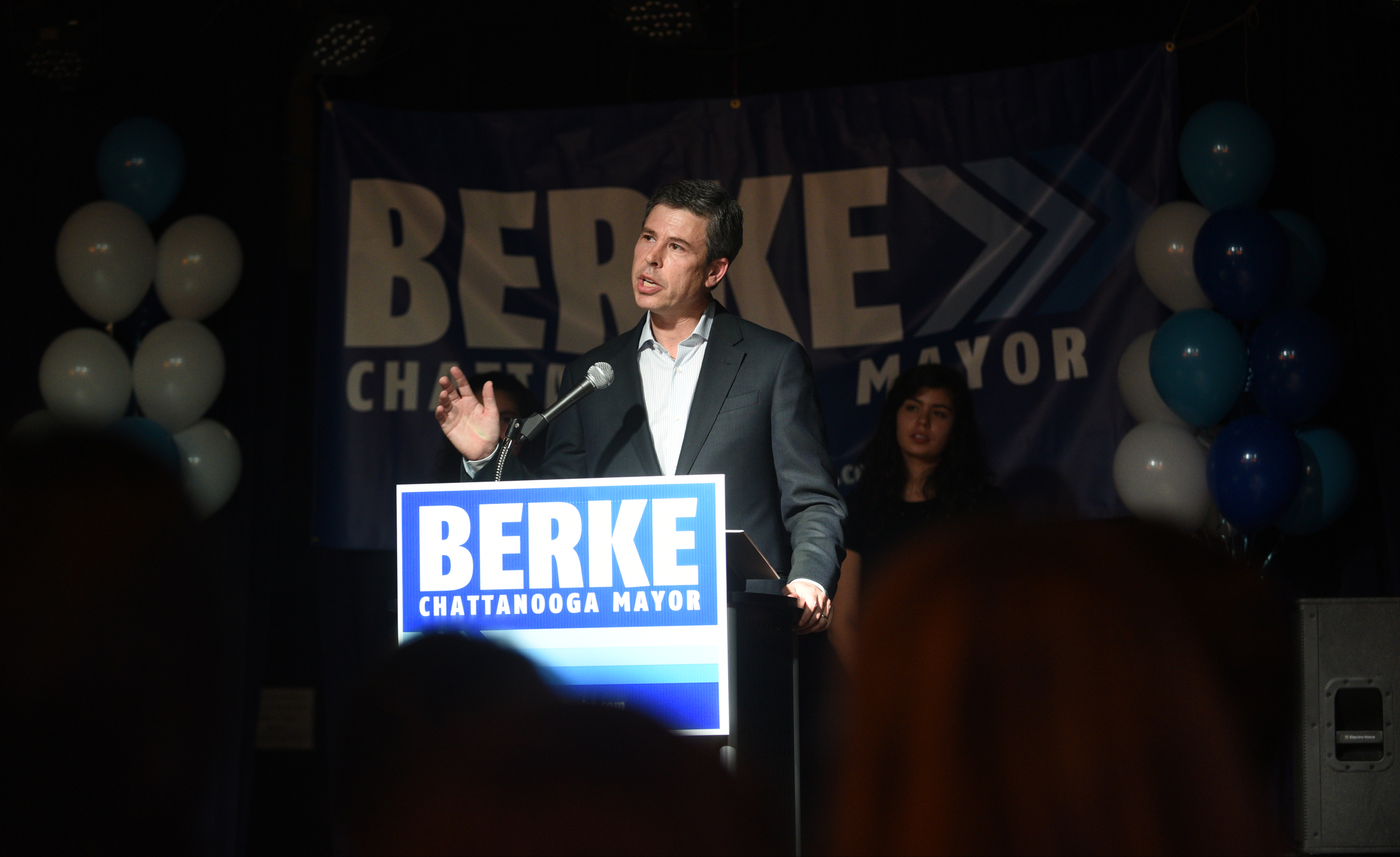
Hamilton County's political party chiefs are still crunching Chattanooga election voter data, but no one contests the races for mayor and City Council failed to draw much of a turnout in comparison to November's presidential election.
Unofficial election results show 18,968 ballots were cast out of 96,333 registered voters, according to Hamilton County Election Commission documents. Most of those votes - 18,872 - played a role in a mayoral race that resulted in the re-election of Andy Berke. That's about a 5.5 percent bump over the 17,873 votes cast in the 2013 mayoral race.
Chattanooga precincts received a 19.7 percent voter turnout on average this election cycle, a far cry from percentages that ranged in the 60s during the presidential election. When compared to the 16.4 percent turnout of the 111,324 registered voters in the 2013 city election, however, the numbers aren't so different.
It is unclear why there has been a drop of 15,000 voters on Chattanooga rolls since 2013, but the Hamilton County Election Commission website says voters might be purged if they move or if they remain inactive for more than eight years. Voter registration is not permanent.
On Thursday, Republican and Democratic leaders both cited voter fatigue for the big drop.
"It's hard to get people to come out and vote in the winter after a presidential election," Joe DeGaetano, chairman of the Hamilton County Republican Party, said. "If the city and county combined their elections, it would create more opportunity for people to vote in the city election."
Such a move would not only increase voter turnout for city elections, it would save costs for conducting elections, DeGaetano said.
Terry Lee, chairman of the Hamilton County Democratic Party, said it becomes a challenge to connect to voters for local elections when they have burned out on a presidential election. They tend to filter out the media and campaign messages, especially since presidential campaign cycles seem to stretch two years or more, he said.
"They've tuned it out," Lee said.
***
Although voter turnout overall trended similarly to 2013, several precincts saw a leap over what they did last time.
In 2013, Eastdale clocked in at just over 8 percent, but hit 25 percent this election, and St. Elmo went from 16 percent turnout to 28 percent. Riverview jumped from 18 percent to 32 percent - one of the highest performers.
Two of those precincts are located in areas where there were hotly contested City Council races. Eastdale is in District 9, which will see a runoff in April between incumbent Yusuf Hakeem and challenger Demetrus Coonrod. And St. Elmo is in District 7, where challenger Erskine Oglesby Jr. faces incumbent Chris Anderson.
The Hixson precincts straddled the overall average, coming in between 18 percent and 22 percent turnout. In 2013, none of them surpassed 13 percent, placing them below that election's average.
East Brainerd's two precincts tracked just under average for both elections, but still went up from the 11-13 percent range to 15-16 percent.
Overall voter turnout landed about where he thought it would, Lee said.
Lee pointed toward aggressive voter registration efforts by a number of young Democratic candidates who brought out young voters who had not even voted in the presidential election.
Kerry Steelman, administrator of the Hamilton County Elections Office, could not be reached for comment about how many new voters had emerged since the presidential election.
As a whole, the Democratic Party has focused on raising voter awareness on a community level.
He also praised the effectiveness of party mailers sent to voters that not only reminded them to vote, but gave them a snapshot of elections in which they had - or had not - cast ballots.
Lee had no figures to show just yet, but planned to compare mailer lists to voter rolls soon.
DeGaetano, who has only been the Republican chairman for less than a month, said he was not aware of any party-sponsored voter registration drives or any mailers sent to voters that included their recent election history.
***
A Chattanooga precinct results map shows Berke, who brought in around 64 percent of the total vote, had the most support in Chattanooga's core, while runner-up Larry Grohn grabbed more precinct votes in Hixson, Lookout Valley and East Brainerd. In most cases, though, Grohn struggled to take the majority in any precinct he claimed. If the election was based on Lookout Valley alone, he would have won hands down.
Berke had several precincts where he defeated Grohn by a margin of 10 to 1, including Avondale, Bonny Oaks and Dalewood. Other precinct victories for Berke came in closer to his 2:1 overall vote ratio.
Name recognition counts, Amanda Wintersieck, assistant professor of political science at the University of Tennessee at Chattanooga, said in a recent email.
"Berke, as the incumbent, had a significant advantage," Wintersieck said. "Incumbents tend to have better name recognition and a record to point to when campaigning."
Lee attributed Berke's victory to a combination of factors, including a mix of young and old supporters who knocked on doors and manned the phones, respectively. On top of that, he had plenty of money to use on advertisements, he said.
"That's a very difficult combination to beat," Lee said.
Berke's well-funded campaign coffers were a major factor, DeGaetano said.
Although the Chattanooga municipal election is a non-partisan affair, partisan reality plays a big role, Wintersieck said. It comes down to the fact that Berke stood as the sole Democrat facing three challengers left to divide the Republican voter pool.
DeGaetano acknowledged as much when he issued an email the day before the election in which he urged fellow Republicans to vote against the Democrat candidate.
At a glance, one can see a lot of similarities in how the city's precincts went to the Republican and Democratic candidates in the presidential election. However, Donald Trump took some precincts Grohn failed to win or took them with higher margins of victory.
DeGaetano doesn't make too much of it, though.
"It's hard to make comparisons between presidential and mayoral elections," he said.
Contact staff writer Paul Leach at 423-757-6481 or pleach@timesfreepress.com. Follow him on Twitter @pleach_tfp.

